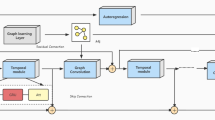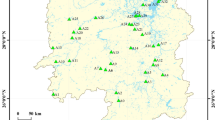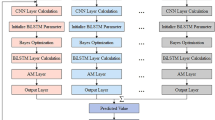Abstract
Water pollution has serious consequences for human health and water ecosystems, and accurate forecasting of water quality changes can aid in the early detection and treatment of such pollution. To better simulate the characteristics of water quality data, the development of a water quality prediction model must consider the non-smoothness of the data as well as the relationship between upstream and downstream water quality. Firstly, Optimal Variational Mode Decomposition (OVMD) technology is used to pre-process water quality monitoring data through linear decomposition into multiple components, with the components acting as a unit of prediction to reduce the difficulty of prediction. Secondly, to reflect the impact of upstream and downstream water quality relationships, comprehensive prediction modeling is carried out on the temporal and spatial correlation of water quality data between monitoring stations. Graph Attention Networks (GAT) are embedded in the Gated Recurrent Unit’s (GRU) reset gate and update gate, and adaptive aggregation of data spatial characteristics of each site based on each station is used to achieve a multi-step prediction of water quality indicators. Finally, the predicted values of each component are then fused to form the final predicted values. Validation at 13 monitoring stations along the Mulan River demonstrated the effectiveness of the integrated prediction model.
The results showed that, under different prediction steps, the Root Mean Square Error (RMSE) and Mean Absolute Error (MAE) values of the GAT-GRU water quality prediction model were reduced by about 11–20% (ammonia nitrogen, NH3–N) and 8–18% (total phosphorus, TP) compared with the GCN (Graph Convolutional Networks)-GRU, and the Nash–Sutcliffe efficiency coefficient (NSE) value was increased by about 20% (NH3–N) and 13% (TP), respectively. The RMSE and MAE values of the OVMD-GAT-GRU water quality prediction model were further reduced by about 52–57% (NH3–N) and 25–35% (TP) compared with GAT-GRU, and the NSE value was increased by about 19–43% (NH3–N) and 15–33% (TP), respectively. As the prediction steps increased, the advantages of OVMD-GAT-GRU over GAT-GRU and GCN-GRU became more pronounced. These results demonstrate that OVMD-GAT-GRU exhibits superior prediction performance, robustness, accuracy, and adaptability to water quality indicators. The development of the OVMD-GAT-GRU water quality prediction model can provide significant assistance in the prevention and management of water pollution.













Similar content being viewed by others
Data availability
The data used to support the findings of this study are available from request the corresponding upon author.
References
Ao D, Yuning Y, Fei L (2022) Dynamic graph convolution neural network based on spatial-temporal correlation for air quality prediction. Ecol Inform 70:101736. https://doi.org/10.1016/j.ecoinf.2022.101736
Bruna J, Zaremba W, Szlam A, LeCun Y (2013) Spectral networks and locally connected networks on graphs. https://doi.org/10.48550/arXiv.1312.6203
Cho K, Merrienboer BV, Gülçehre Ç, Bougares F, Schwenk H, Bengio Y (2014) Learning phrase representations using rnn encoder-decoder for statistical machine translation. https://doi.org/10.48550/arXiv.1406.1078
Dai G, Ma C, Xu X (2019) Short-term traffic flow prediction method for urban road sections based on space-time analysis and GRU. IEEE Access 7:143025–143035. https://doi.org/10.1109/ACCESS.2019.2941280
Diao Z, Wang X, Zhang D, Liu Y, Xie K, He S (2019) Dynamic spatial-temporal graph convolutional neural networks for traffic forecasting. Proc AAAI Conf Artif Intell 33:890–897. https://doi.org/10.1609/aaai.v33i01.3301890
Dong M, Mitani A (2023) Multiple imputation methods for missing multilevel ordinal outcomes. BMC Med Res Methodol 23(1):112. https://doi.org/10.1186/s12874-023-01909-5
Dragomiretskiy K, Zosso D (2014) Variational mode decomposition. IEEE Trans Signal Process 62(3):531–544. https://doi.org/10.1109/TSP.2013.2288675
Farizan A, Norfatimah MY, Aili ZN, Lyena WZA, Indah MA (2021) Use of cytological and molecular biological method for water pollution monitoring. IOP Conf Ser: Earth Environ Sci 674(1):012108. https://doi.org/10.1088/1755-1315/674/1/012108
Franco S, Marco G, Chung TA, Markus H, Gabriele M (2009) The graph neural network model. IEEE Trans Neural Netw 20(1):61–80. https://doi.org/10.1109/TNN.2008.2005605
Frasconi P, Gori M, Sperduti A (1998) A general framework for adaptive processing of data structures. IEEE Trans Neural Netw 9(5):768–786. https://doi.org/10.1109/72.712151
Gao S, Huang Y, Zhang S, Han J, Wang G, Zhang M, Lin Q (2020) Short-term runoff prediction with GRU and LSTM networks without requiring time step optimization during sample generation. J Hydrol 589:125188. https://doi.org/10.1016/j.jhydrol.2020.125188
Ghaemi E, Tabesh M, Nazif S (2022) Improving the ARIMA model prediction for water quality parameters of urban water distribution networks (case study: CANARY dataset). Int J Environ Res 16(6):98. https://doi.org/10.1007/s41742-022-00482-x
He H, Ye K, Xu CZ (2021) Multi-feature urban traffic prediction based on unconstrained graph attention network. IEEE Int Conf Big Data (Big Data) 2021:1409–1417. https://doi.org/10.1109/BigData52589.2021.9671619
He K, Zhang X, Ren S, Sun J (2015) Delving deep into rectifiers surpassing human-level performance on imagenet classification. In: proceedings of the IEEE international conference on computer vision, 1026–1034. https://openaccess.thecvf.com/content_iccv_2015/html/He_Delving_Deep_into_ICCV_2015_paper.html
Hinton GE, Srivastava N, Krizhevsky A, Sutskever I, Salakhutdinov RR (2012) Improving neural networks by preventing co-adaptation of feature detectors. arXiv preprint. https://doi.org/10.48550/arXiv.1207.0580
Huan J, Liao W, Zheng Y, Xu X, Zhang H, Shi B (2023) A deep learning model with spatio-temporal graph convolutional networks for river water quality prediction. Water Supply 23(7):2940–2957. https://doi.org/10.2166/ws.2023.164
Huang N, Wu Y, Cai G, Zhu H, Yu C, Jiang L, Zhang Y, Zhang J, Xing E (2019) Short-term wind speed forecast with low loss of information based on feature generation of OSVD. IEEE Access 7:81027–81046. https://doi.org/10.1109/ACCESS.2019.2922662
Kang Y, Song J, Lin Z, Huang L, Zhai X, Feng H (2022) Water quality prediction based on SSA-MIC-SMBO-ESN. Comput Intell Neurosci 2022:1264385. https://doi.org/10.1155/2022/1264385
Li L, Lv N, Li W (2022) Research on application of graph neural network in water quality prediction. Int J Artif Intell Tools 31(01):2250018. https://doi.org/10.1142/S021821302250018X
Li Q, Yang Y, Yang L, Wang Y (2023) Comparative analysis of water quality prediction performance based on LSTM in the Haihe River Basin China. Environ Sci Pollut Res 30(3):7498–7509. https://doi.org/10.1007/s11356-022-22758-7
Lin Y, Li L, Yu J, Hu Y, Zhang T, Ye Z, Syed A, Li J (2021) An optimized machine learning approach to water pollution variation monitoring with time-series Landsat images. Int J Appl Earth Obs Geoinf 102:102370. https://doi.org/10.1016/j.jag.2021.102370
Lin Y, Qiao J, Bi J, Yuan H, Gao H, Zhou M (2022) Hybrid water quality prediction with graph attention and spatio-temporal fusion. In: 2022 IEEE international conference on systems, man, and cybernetics (SMC), 1419–1424. https://doi.org/10.1109/SMC53654.2022.9945293
Liu T, Luo Z, Huang J, Yan S (2018) A comparative study of four kinds of adaptive decomposition algorithms and their applications. Sensors 18(7):2120. https://doi.org/10.3390/s18072120
Liu Y, Yang G, Li M, Yin H (2016) Variational mode decomposition denoising combined the detrended fluctuation analysis. Signal Process 125:349–364. https://doi.org/10.1016/j.sigpro.2016.02.011
Loshchilov I, Hutter F (2018) Fixing weight decay regularization in Adam. https://openreview.net/forum?id=rk6qdGgCZ
Muthukumar P, Cocom E, Nagrecha K, Comer D, Burga I, Taub J, Calvert CF, Holm J, Pourhomayoun M (2022) Predicting PM25 atmospheric air pollution using deep learning with meteorological data and ground-based observations and remote-sensing satellite big data. Air Qual Atmos Health 15(7):1221–1234. https://doi.org/10.1007/s11869-021-01126-3
Ni Q, Cao X, Tan C, Peng W, Kang X (2023) An improved graph convolutional network with feature and temporal attention for multivariate water quality prediction. Environ Sci Pollut Res 30(5):11516–11529. https://doi.org/10.1007/s11356-022-22719-0
Radiuk PM (2017) Impact of training set batch size on the performance of convolutional neural networks for diverse datasets. https://doi.org/10.1515/itms-2017-0003
Rubin DB (2004) Multiple imputation for nonresponse in surveys, vol 81. Wiley, Hoboken
Sijtsma K, Pfadt JM (2021) Part II: On the use, the misuse, and the very limited usefulness of Cronbach’s alpha: discussing lower bounds and correlated errors. Psychometrika 86(4):843–860. https://doi.org/10.1007/s11336-021-09789-8
Smith LN (2018) A disciplined approach to neural network hyper-parameters: Part 1—learning rate, batch size, momentum, and weight decay. https://doi.org/10.48550/arXiv.1803.09820
Su J, Ji D, Lin M, Chen Y, Sun Y, Huo S, Zhu J, Xi B (2017) Developing surface water quality standards in China. Resour Conserv Recycl 117:294–303. https://doi.org/10.1016/j.resconrec.2016.08.003
Veličković P, Cucurull G, Casanova A, Romero A, Liò P, Bengio Y (2017) Graph attention networks. https://doi.org/10.48550/ARXIV.1710.10903
Wolf AT (2007) Shared waters: conflict and cooperation. Annu Rev Environ Res 32(1):241–269. https://doi.org/10.1146/annurev.energy.32.041006.101434
Wu H, Cheng S, Xin K, Ma N, Chen J, Tao L, Gao M (2022) Water quality prediction based on multi-task learning. Int J Environ Res Public Health 19(15):9699. https://doi.org/10.3390/ijerph19159699
Wu J, Wang Z (2022) A hybrid model for water quality prediction based on an artificial neural network, wavelet transform, and long short-term memory. Water 14(4):610. https://doi.org/10.3390/w14040610
Zarzycki K, Ławryńczuk M (2021) LSTM and GRU neural networks as models of dynamical processes used in predictive control: a comparison of models developed for two chemical reactors. Sensors 21(16):5625. https://doi.org/10.3390/s21165625
Zhang C, Yu JJQ, Liu Y (2019a) Spatial-temporal graph attention networks: a deep learning approach for traffic forecasting. IEEE Access 7:166246–166256. https://doi.org/10.1109/ACCESS.2019.2953888
Zhang G, Liu H, Zhang J, Yan Y, Zhang L, Wu C, Hua X, Wang Y (2019b) Wind power prediction based on variational mode decomposition multi-frequency combinations. J Mod Power Syst Clean Energy 7(2):281–288. https://doi.org/10.1007/s40565-018-0471-8
Zhang Y, Zhao Y, Gao S (2019c) A novel hybrid model for wind speed prediction based on VMD and neural network considering atmospheric uncertainties. IEEE Access 7:60322–60332. https://doi.org/10.1109/ACCESS.2019.2915582
Zhou S, Song C, Zhang J, Chang W, Hou W, Yang L (2022) A hybrid prediction framework for water quality with integrated W-ARIMA-GRU and LightGBM methods. Water 14(9):1322. https://doi.org/10.3390/w14091322
Funding
The work is supported by the S&T Program of Hebei (Grant No. 21370103D and 21373301D) and the 2023 Scientific Research Project of Higher Education Institutions in Hebei Province (Grant No. ZC2023123).
Author information
Authors and Affiliations
Contributions
JS and HM wrote the main text of the manuscript. YK, MZ, and YZ corrected the language of the manuscript. JZ provided technical support. All authors reviewed the manuscript.
Corresponding author
Ethics declarations
Conflict of interest
The authors declare that they have no conflicts of interest.
Additional information
Publisher's Note
Springer Nature remains neutral with regard to jurisdictional claims in published maps and institutional affiliations.
Rights and permissions
Springer Nature or its licensor (e.g. a society or other partner) holds exclusive rights to this article under a publishing agreement with the author(s) or other rightsholder(s); author self-archiving of the accepted manuscript version of this article is solely governed by the terms of such publishing agreement and applicable law.
About this article
Cite this article
Song, J., Meng, H., Kang, Y. et al. A method for predicting water quality of river basin based on OVMD-GAT-GRU. Stoch Environ Res Risk Assess 38, 339–356 (2024). https://doi.org/10.1007/s00477-023-02584-0
Accepted:
Published:
Issue Date:
DOI: https://doi.org/10.1007/s00477-023-02584-0




